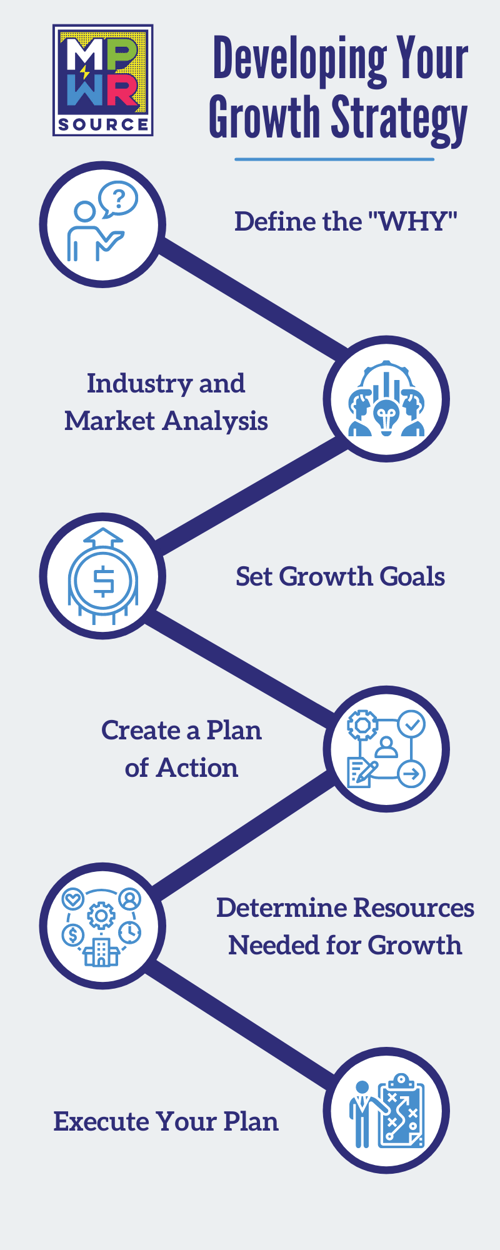New Business Challenges
Many people think that coming up with a business idea is the most difficult challenge, but that is...

Most businesses want to grow because the leaders of businesses are fueled by ambition. However, according to the Bureau of Labor Statistics, approximately 20% of new businesses fail during the first two years; 45% during the first five years; and 65% during the first 10 years. Therefore, it is safe to assume that most businesses lack a growth strategy or plan. This lack of a growth strategy causes them to remain stagnate, ever in a constant reactionary mode to your ever-changing customer base and market fluctuations. To prevent stagnation or worse, “going out of business”, a growth strategy needs to be developed. And much like a business plan, a growth strategy is not a strategy that is set in stone. It must be able to pivot and change with the demands of your customer base and market, ever in a state of evolution. Oftentimes, businesses need help developing a growth strategy. In those cases, it is best to reach out to a growth agency.
 A growth strategy allows the business to consider the means by which to grow. For example, the plan may evaluate adding new locations, franchising opportunities, product line expansions, new service lines, investing in customer acquisition, online selling through multiple channels, and mergers and acquisitions. However, before deciding how a business will grow, a deep understanding of the business’s industry and target market must occur. The first step to mapping out a growth strategy is to understand the business’s why.
A growth strategy allows the business to consider the means by which to grow. For example, the plan may evaluate adding new locations, franchising opportunities, product line expansions, new service lines, investing in customer acquisition, online selling through multiple channels, and mergers and acquisitions. However, before deciding how a business will grow, a deep understanding of the business’s industry and target market must occur. The first step to mapping out a growth strategy is to understand the business’s why.

Before any decision or strategy is fully mapped out, a deep understanding of the business’s “why” is required. Growth agencies excel at asking why. As Simon Sinek stated, “People don’t buy what you do, they buy why you do it.” For example, Apple’s “why” is to make beautifully designed, simple to use, and user-friendly products. Before mapping out target markets and growth opportunities, the business’s “why” must be defined. The purpose of the business must be clearly defined. It is not just a marketing issue or for branding. Before any decision is made within a company, the following question should be asked, “Will this decision support the business’s purpose?”
According to a Forbes article, “Understanding Your Why in Business Through The Eight Purpose Archetypes” by Stan Phelps, he and Graeme Newell conducted a crowd sourcing effort called the Red Goldfish Project. In this project, they collected information on 200 companies, specifically looking for ways that brands bring purpose to live. They uncovered eight purpose archetypes:
Thus, knowing the “why” or the archetype/purpose of the business will set the course for growth. Everything builds off the purpose.
The why and purpose may be well defined, but now data and research must be conducted to justify why a business wants to grow in that area (or even if growth is possible). Market research is an integral step in a growth strategy. Market research defines a business’s markets; evaluates competitors; and defines customers wants and needs. Third party research and case studies, surveys, feasibility studies, and focus groups are a few examples of market research. A growth agency or a market research firm can help a business with this. The information brought forth in market research will help set expectations and growth goals.
Market research helps to uncover “the why” of the customer”. Neglecting market research results in indecision, inaction, or too many options. Once the market research has been conducted and evaluated the magic begins to happen because now the business’s why and the customers’ why can align to set forth a successful growth strategy.
When the business’s why and the customers’ why aligns, growth opportunities present themselves leading a clear path to opportunities for growth.
Once the why has been defined and the industry and market has been evaluated, now the business needs to determine how much to grow. One should never assume that all businesses look for world domination. Each business, much like an individual, has its own aspirations. One may seek a growth goal so that the business will eventually support the current lifestyle of a family, but another may seek to become international, seeking to positively impact people around the world.
Goals should always be achievable and realistic, so by conducting market and industry research setting realistic goals becomes possible. Realistic and achievable goals are also known as SMART goals.
S – Specific (simple, sensible, significant)
M – Measurable (meaningful, motivating)
A – Achievable (agreed, attainable)
R – Relevant (reasonable, realistic and resourced, results-based)
T – Time bound (time-based, timely)
For example, “aiming to grow sales by 25% year-over-year for the next three years” is much clearer than “increasing sales”.
Prior to establishing a plan of action, the business (ownership, c-suite, executives, etc.) must understand and buy-into the overall growth strategy. Once buy-in is achieved, moving forward with setting a plan of action is easier, with all respective players eager to implement their role in the growth strategy.
Additionally, before setting forth a plan of action, conducting an internal SWOT is important. SWOT stands for strengths, weaknesses, opportunities, and threats. The SWOT analysis helps the business understand the business’s advantages, disadvantages, hazards, and opportunities. For growth to be achieved, all departments must work together. The resources must be in place to manage the growth. For example, if a business has a plan to sell 30% more widgets next quarter, what resources need be in play to handle such growth? For example, can manufacturing and the supply chain support such growth?
The plan of action encompasses all aspects of business and requires collaboration from all departments. Therefore, the action plan should contain a list of action items, deadlines, teams or persons responsible, and resources for attaining your growth goal.
 Determine Resources Needed for Growth
Determine Resources Needed for Growth Before the growth strategy and plan can be executed, an evaluation of resources needed must be conducted. For example, does the business have the necessary capital or cash to see the growth plan through? Does the business have the necessary tools, technology, or software to expedite the plan or to gain insights from the growth process? Does the business have all the intellectual capital needed to enact the growth strategy, or should help be sought from consultants, designers, or planners? Growth agencies often have the services that drive revenue and supplement a business's team to implement growth strategies.
Now, the business can execute the growth plan and deliver results for the business. However, each stakeholder must be held accountable. Growth is a team sport. No individual or department grows a business on its own. Execution depends on open communication and the ability to pivot and make adjustments when reviewing data and results.

Many people think that coming up with a business idea is the most difficult challenge, but that is...

A growth agency helps organizations reach revenue goals and growth objectives by...